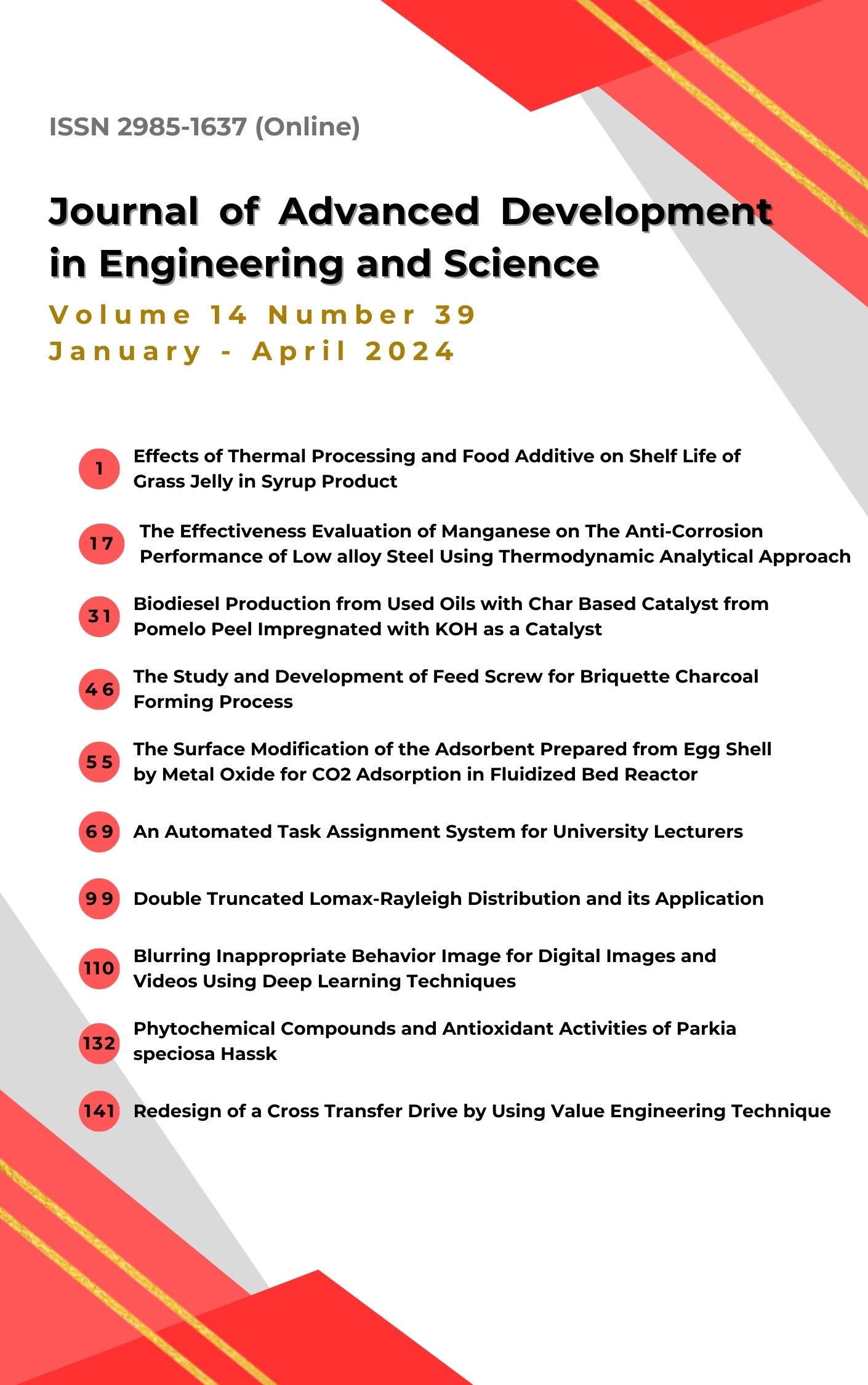การผลิตไบโอดีเซลจากน้ำมันเหลือทิ้งโดยใช้ถ่านเปลือกส้มโอที่เคลือบด้วย KOH เป็นตัวเร่งปฏิกิริยา
Main Article Content
บทคัดย่อ
ในงานวิจัยนี้จะเป็นการนำถ่านที่ได้จากกระบวนการไพโรไลซิสเปลือกส้มโอมาใช้ประโยชน์ด้วยการนำ มาเป็นตัวรองรับโพแทสเซียมไฮดรอกไซด์ (KOH) แล้วนำมาใช้เป็นตัวเร่งปฏิกิริยาแบบวิวิธพันธุ์ของกระบวนการ ผลิตไบโอดีเซลจากน้ำมันพืชใช้แล้วด้วยปฏิกิริยาทรานเอสเทอริฟิเคชัน โดยศึกษาปัจจัยต่างๆคืออัตราส่วนโดย โมลระหว่างน้ำมันต่อเมทานอล อุณหภูมิที่ใช้ในการทำปฏิกิริยา เวลาที่ใช้ในการทำปฏิกิริยาระบบ (เอกพันธุ์และวิวิธพันธุ์) และปริมาณของตัวเร่งปฏิกิริยา ผลการทดลองพบว่าอัตราส่วนโดยโมลระหว่างน้ำมันต่อเมทานอล ที่ดีที่สุดเป็น 1:6 อุณหภูมิที่ใช้เป็น 60 oC เวลา 1 ชั่วโมง ในระบบตัวเร่งปฏิกิริยาแบบเอกพันธุ์ที่มีโพแทสเซียม ไฮดรอกไซด์ร้อยละ 2 โดยน้ำหนักให้ร้อยละผลผลิตไบโอดีเซลสูงสุดเป็น 90.01 ส่วนในระบบตัวเร่งปฏิกิริยาแบบวิวิธพันธุ์ที่มีโพแทสเซียมไฮดรอกไซด์เคลือบฝังอยู่บนตัวรองรับถ่านที่ได้จากกระบวนการไพโรไลซิสเปลือกส้มโอที่มีโพแทสเซียมไฮดรอกไซด์เคลือบอยู่ปริมาณร้อยละ 4 โดยน้ำหนักให้ร้อยละผลผลิตไบโอดีเซลสูงสุดเพียง 87.38 แต่อย่างไรก็ตามตัวเร่งปฏิกิริยาแบบวิวิธพันธุ์นั้นจะมีความเหมาะสมในการผลิตจริงมากกว่าเนื่องจากสามารถแยกตัวเร่งปฏิกิริยาออกมาจากระบบได้ง่ายกว่า ดังนั้นงานวิจัยนี้จึงนำไบโอดีเซลที่ผลิตจากระบบตัวเร่งปฏิกิริยาแบบวิวิธพันธุ์ที่มีโพแทสเซียมไฮดรอกไซด์ร้อยละ 4 โดยน้ำหนักไปวิเคราะห์องค์ประกอบด้วยเครื่อง GC-MS พบว่าไบโอดีเซลที่ได้ประกอบด้วยเมทิลเอสเตอร์หลายชนิด ได้แก่ methyl oleate, methyl palmitate, methyl stearate, metyl palmitelaidate และเมื่อนำไปเปรียบเทียบกับมาตรฐานไบโอดีเซลพบว่าไบโอดีเซลที่ได้นี้มีสมบัติต่างๆ ได้แก่ ความหนาแน่น ความหนืด จุดวาบไฟ ค่าความเป็นกรด เป็นไปตามมาตรฐานของยุโรป (EN 14214) และมาตรฐานของกรมธุรกิจพลังงานกระทรวงพลังงาน
Article Details

อนุญาตภายใต้เงื่อนไข Creative Commons Attribution-NonCommercial-NoDerivatives 4.0 International License.
เนื้อหาและข้อมูลในบทความที่ลงตีพิมพ์ใน Journal of Advanced Development in Engineering and Science ถือเป็นข้อคิดเห็นและความรับผิดชอบของผู้เขียนบทความโดยตรง ซึ่งกองบรรณาธิการวารสารไม่จำเป็นต้องเห็นด้วยหรือร่วมรับผิดชอบใดๆ
บทความ ข้อมูล เนื้อหา ฯลฯ ที่ได้รับการตีพิมพ์ในJournal of Advanced Development in Engineering and Science ถือเป็นลิขสิทธิ์ของ Journal of Advanced Development in Engineering and Science หากบุคคลหรือหน่วยงานใดต้องการนำทั้งหมดหรือส่วนหนึ่งส่วนใดไปเผยแพร่ต่อหรือเพื่อกระทำการใดๆ จะต้องได้รับอนุญาตเป็นลายลักษณ์อักษรจาก Journal of Advanced Development in Engineering and Scienceก่อนเท่านั้น
เอกสารอ้างอิง
Tippayawong, N & Sittisun, P. (2012). Continuous-Flow Transesterification of Crude Jatropha Oil with Microwave Irradiation. Scientia Iranica B. 19(5), 1324-1328.
Jon, V.G. (2005). Biodiesel Processing and Production. Fuel Processing Technology, 86(10), 1097-1107.
Yaakob, Z., et al. (2013). Overview of the Production of Biodiesel from Waste Cooking Oil. Renewable and Sustainable Energy Reviews, 18, 184–193.
Talebian-Kiakalaieh, A., et al. (2013). A Review on Novel Processes of Biodiesel Production from Waste Cooking Oil. Applied Energy, 104, 683-710.
Enweremadu, C. C. & Mbarawa, M. M. (2009). Technical Aspects of Production and Analysis of Biodiesel from Used Cooking Oil - A Review. Renewable and Sustainable Energy Reviews, 13(9), 2205-2224.
Verma, P & Sharma,M.P. (2016). Review of Process Parameters for Biodiesel Production from Different Feed Stocks. Renewable and Sustainable Energy Reviews, 62, 1063–1071.
Gebremariam, S. N. & Marchetti, J. M. (2017). Biodiesel Production Technologies: Review. AIMS Energy, 5(3), 425-457.
Narowska, B. E., et al. (2020). Application of Activated Carbon to Obtain Biodiesel from Vegetable Oils. Catalysts, 10(9), 1049-1062.
Taslim, T., et al. (2018). Preparation of Activated Carbon-Based Catalyst from Candlenut Shell Impregnated with KOH for Biodiesel Production. Key Engineering Materials, 777, 262-267.
Asri, N. P., et al. (2018). Alumina Supported Zinc Oxide Catalyst for Production of Biodiesel from Kesambi Oil and Optimization to Achieve Highest Yields of Biodiesel. Euro - Mediterranean Journal for Environmental Integration, 3, 3(2018).
Fawaz, E. G., et al. (2021). Hierarchical Zeolites as Catalysts for Biodiesel Production from Waste Frying Oils to Overcome Mass Transfer Limitations. Molecules, 26(16), 4879.
Al-Rumaihi, A., et al. (2022). A Review of Pyrolysis Technologies and Feedstock: A Blending Approach for Plastic and Biomass Towards Optimum Biochar Yield. Renewable and Sustainable Energy Reviews, 167, 112715.
Lee, J., et al. (2017). Biochar as a Catalyst. Renewable and Sustainable Energy Reviews, 77, 70-79.
Bo-ongcharoenlab, K., et al. (2023). Effect of Particle Size of Rice-Husk Derived Silica on the Pyrolysis of Pomelo Peels. Bulletin of Chemical Reaction Engineering & Catalysis, 18(3), 473-484.
Patil, P. D. & Deng, S. (2009). Optimization of Biodiesel Production from Edible and Non-Edible Vegetable Oils. Fuel, 88(7), 1302-1306.
Hossain, M., et al. (2021). Box–Behnken Design-Based Optimization for Biodiesel Production from Waste Cooking Oil using Mahogany (Swietenia macrophylla) Fruit Shell Derived Activated Carbon as a Heterogeneous Base Catalyst. Reaction Kinetics, Mechanisms and Catalysis, 133, 117–138.
Joshi, S. & Pokharel, B. P. (2013). Preparation and Characterization of Activated Carbon from Lapsi (Choerospondias axillaris) Seed Stone by Chemical Activation with Potassium Hydroxide. Journal of the Institute of Engineering, 9(1), 79–88.
Keihani, M., et al. (2018). Biodiesel Production from Chicken Fat Using Nano-calcium Oxide Catalyst andImproving the Fuel Properties via Blending with Diesel. Physical Chemistry Research, 6(3), 521-529.
Musa, I. A. (2016). The Effects of Alcohol to Oil Molar Ratios and the Type of Alcohol on Biodiesel Production using Transesterification Process. Egyptian Journal of Petroleum. 25(1), 21-31.
Lakshmana, N. R., et al. (2015). Optimized Parameters for Production of Biodiesel from Fried Oil. International Advanced Research Journal in Science, Engineering and Technology, 2(6), 62-65.
Jamnongphol.,S., et al. (2020). Rice Husk-Derived Silica as a Support for Zirconocene/ MMAO Catalyst in Ethylene Polymerization. Waste and Biomass Valorization, 11, 769–779.
Chhetri, A. B., et al. (2008). Waste Cooking Oil as an Alternate Feedstock for Biodiesel Production. Energies, 1(1), 3-18.
Kusmiyati, K., et al. (2019). Biodiesel Production from Reutealis Trisperma Oil Using KOH Impregnated Eggshell as a Heterogeneous. Catalyst Energies, 12(19), 3714.
Sneha, E. M., et al. (2015). Biodiesel Production from Waste Cooking Oil Using KBr Impregnated CaO as Catalyst. Energy Conversion and Management, 91, 442–450.

